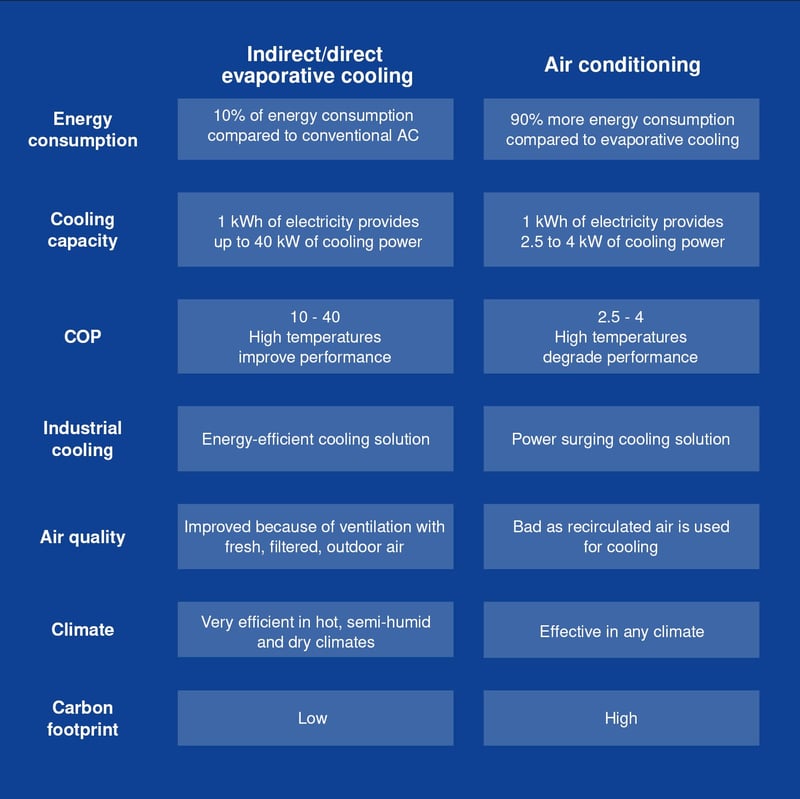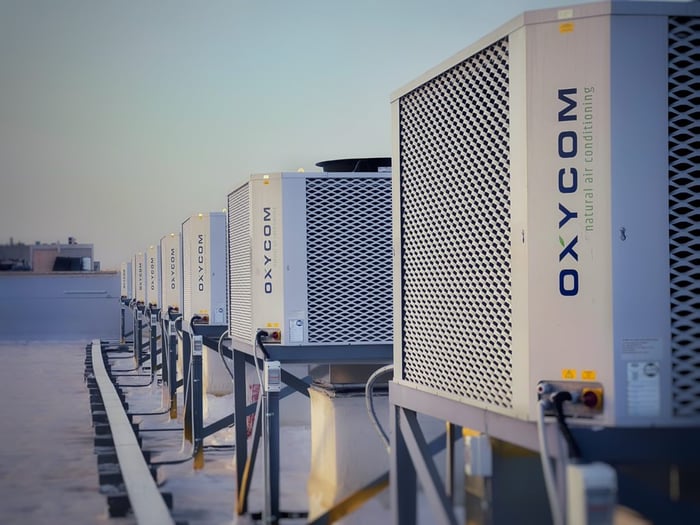There are misconceptions about the efficiency of evaporative cooling over air conditioning even though it has proven to be an effective and sustainable cooling solution in comparison to air conditioning. This blog will give you a deeper understanding of these misconceptions, the pros and cons of evaporative cooling versus air conditioning, and vice versa.
Misconceptions and facts:
1. Evaporative cooling creates a subtropical indoor climate compared to air conditioning.
Air conditioning cools and dehumidifies the air. Deep cooling causes the moisture in the air to condense on the cold evaporator. The cooled air then contains less moisture. Comfortable in terms of temperature and humidity (30% - 60% as per OSHA), but not always healthy. To reduce energy costs, ventilation is minimized.
Two-stage evaporative cooling is superior to direct evaporative cooling, it cools considerably deeper and ensures up to 70% lower humidity in the supply air. Resulting in comfortable temperature and humidity levels. Other than air conditioning, two-stage evaporative cooling is depending on ventilating fresh cooled air into the building and extracting the used air to the outdoors, resulting in a comfortable, healthy, and fresh indoor environment with a typical humidity level between 40% and 60%. This slightly higher humidity level helps us fend off viruses and provides comfort against dry eyes and an itchy throat.
For more information on the efficiency of evaporative cooling vs air conditioning, check our page: Evaporative cooling vs air conditioning.
2. Evaporative cooling is less effective than air conditioning in providing comfort to people in hot and humid climates.
It is true that evaporative cooling units become less effective in humid climates. However, two-stage (indirect/direct) evaporative cooling can provide deeper cooling (4 to 7 ºC) than (direct) evaporative cooling. The combination of massive ventilation and cooling results in a pleasant working environment even in a humid climate. Should this not be sufficient, a hybrid solution can be chosen, more on this in listing 3.
A key advantage of two-stage evaporative cooling is that the technology becomes more efficient and performs better as the temperature rises, unlike air conditioning. In the case of two-stage evaporative cooling, the COP will go from 10 to 40 as the temperature rises. A typical COP of 4 with an air conditioner, goes down to 2.5/3 as the temperature rises.
Read more on our website: Effectiveness of evaporative cooling in different climates.
3. Evaporative cooling works by cooling the air by allowing it to absorb water vapor. This can only occur if the relative humidity is low and the outside temperature is below the wet bulb temperature.
In cases of high relative humidity, efficient cooling can be achieved by combining the two-stage evaporative cooling with a small mechanical cooling system. This semi-hybrid evaporative cooling system stands out to be the optimal solution in case of high relative humidity. With this semi-hybrid system, a production hall or building can be cooled adequately throughout the year, even in humid months, without losing the extensive energy-saving benefits of two-stage evaporative cooling.
Read the success case from our customer in Saudi Arabia: Semi-hybrid comfort cooling for Almarai's guesthouse in Saudi Arabia.

Sustainable climate control for large buildings
IntrCooll: An efficient solution for sustainable cooling, heating, and ventilation.
During spring, winter, or fall, the IntrCooll system uses the outdoor air smartly to ventilate and cool. When the outside temperatures increase beyond a temperature of 18-22 °C, the IntrCooll system switches to two-stage evaporative cooling; the outside air is cooled in the first stage using cold recirculation water and further cooled down by direct evaporation in the second stage. IntrCooll delivers up to 40 kW of cooling power with 1 kWh of electricity. IntrCooll EER (Energy Efficiency Ratio) can go up to 40. This so-called EER is a factor 10 higher than traditional cooling systems.
During winter, Oxycom’s patented IntrCooll climate control system can be combined with a natural ventilator box (no extraction fans needed) and a Heat Reclaim Module for heat reuse. Additional heating can be provided by connecting the Heat Reclaim Module with a heat pump.
/Book%20cover%20pictures%20(whitepapers%20and%20case%20studies)/EN/Challanges%20and%20opportunities/Challenges%20%26%20Opportunities%20mock%20up%20-%20optimized.png?width=295&height=226&name=Challenges%20%26%20Opportunities%20mock%20up%20-%20optimized.png) Download our whitepaper “Challenges and Opportunities for Energy-Efficient Climate Control” and discover how to create a comfortable and sustainable indoor climate within your production facility.
Download our whitepaper “Challenges and Opportunities for Energy-Efficient Climate Control” and discover how to create a comfortable and sustainable indoor climate within your production facility.
For more information on our innovative evaporative cooling and ventilation technique, check out our webpage, "Evaporative cooling."
If you would like to know more about our two-stage evaporative technology solution, please get in touch with us at +31 572 349 400, or fill in the form directly with your question:





